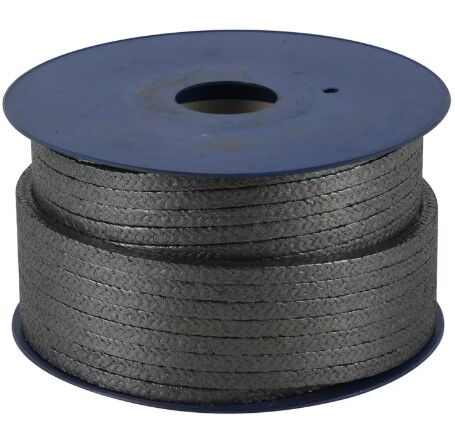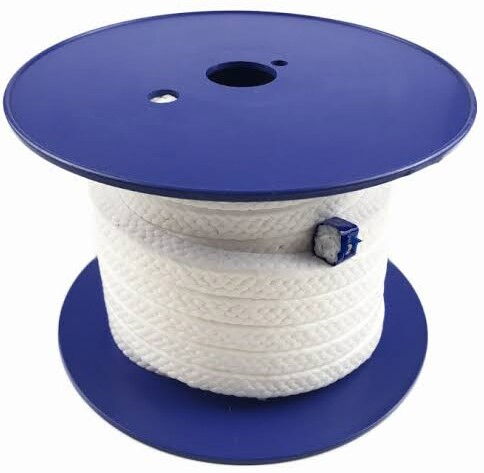In the vast framework of modern industry, sealing technology may not be immediately visible, yet it plays an indispensable role. From high-temperature, high-pressure chemical reactors to precisely operating mechanical equipment, sealing components act as loyal guardians, silently protecting the safety and stable operation of machinery. Today, let us step into the world of graphite packing and PTFE packing, and gain an in-depth understanding of these two materials that shine brightly in the field of industrial sealing.
Graphite packing is a highly distinctive sealing material, born out of the stringent demands of high-temperature and high-pressure conditions. This packing is primarily made from various reinforced fibers, such as steel wire, copper wire, nickel wire, carbon fiber, pre-oxidized yarn, or glass yarn, combined with graphite yarn and processed through exquisite weaving techniques. Its unique material composition and craftsmanship give it exceptional performance, allowing it to perform impressively even under extreme and harsh environments.

One cannot talk about graphite packing without mentioning its remarkable temperature resistance. In high-temperature environments, many materials gradually lose their properties or even undergo physical or chemical changes. Graphite packing, however, can operate stably at temperatures up to approximately 2500°C. This is achieved through a solid-phase carbonization process during production. In this process, non-carbon elements in the carbon fibers, such as nitrogen, are almost entirely removed, resulting in graphite fibers with nearly 100% carbon content. The stable structure of these high-purity graphite fibers enables them to maintain excellent performance under high temperatures. Its thermal conductivity is also outstanding. This means that in high-temperature environments, graphite packing can conduct heat more efficiently, ensuring even internal temperature distribution, preventing localized overheating and equipment damage, and thereby meeting the rigorous requirements of high-temperature sealing in industrial production.
Beyond temperature resistance, graphite packing also exhibits outstanding chemical stability. It can resist corrosion from nearly all media except for a few strong oxidants. Whether it is hot water, superheated steam, heat transfer fluids, ammonia solutions, hydrocarbons, or low-temperature liquids, graphite packing can handle them all with ease. In the chemical industry, where exposure to strong acids and bases is common, graphite packing's exceptional chemical stability allows it to operate reliably over long periods, effectively preventing leaks and ensuring smooth chemical production while reducing potential safety hazards and environmental pollution caused by leakage.
Graphite packing is suitable for a wide range of applications. It performs powerful sealing functions in key equipment such as valves, pumps, and reactors. Take valves as an example: as critical components for controlling fluid flow, their sealing performance directly affects the normal operation of the entire production system. Graphite packing tightly conforms to the valve stem, forming a reliable seal that effectively prevents media leakage even under high pressure and frequent operation. For pumps, graphite packing can be installed at the shaft seal to prevent fluid leakage while ensuring operational efficiency. In reactors, which must withstand high temperature, high pressure, and various complex chemical reactions, graphite packing's high strength and corrosion resistance make it well-suited for these conditions, ensuring smooth reactions and providing a stable environment for chemical production.
Like graphite packing, PTFE (polytetrafluoroethylene) packing holds a significant position in industrial sealing. Its unique chemical inertness and wide applicability make it a preferred sealing material across many industrial sectors.

PTFE packing's most prominent feature is its outstanding chemical inertness. This material hardly reacts with any chemicals, acids, or solvents. Whether it is strong acids like concentrated sulfuric or nitric acid, or strongly corrosive bases, PTFE packing remains stable, resisting corrosion and deformation. This exceptional chemical resistance has led to its widespread use in industrial equipment that handles oxidizing or corrosive media. In chemical production, where complex reactions and corrosive substances are frequently encountered, PTFE packing greatly enhances equipment safety and reliability, reducing the risk of equipment damage and production accidents caused by material corrosion.
In addition to chemical stability, PTFE packing also excels in temperature adaptability. It can maintain stable performance in extreme conditions, from very low temperatures up to over 250°C. In specialized industrial sectors, such as aerospace, chemical processing, and power systems, equipment may face drastic temperature changes or high-temperature operations. PTFE packing, with its wide temperature range, can maintain excellent sealing performance under these harsh conditions without experiencing expansion, contraction, or deformation, ensuring long-term stable operation.
Another significant advantage of PTFE material is its low friction coefficient. In mechanical equipment, friction between packing and moving parts is inevitable. PTFE packing's low friction reduces this friction, lowering energy consumption during operation. For frequently moving equipment, such as pumps and valves, PTFE packing can minimize wear and leakage risk, extend equipment lifespan, and reduce maintenance costs. This low-friction property not only improves operational efficiency but also brings notable energy-saving benefits to industrial production.
PTFE packing is widely used across industries, including petrochemical, textile, paper, chemical, and power sectors. It is commonly used to seal mineral oils, solvents, paints, and corrosive chemicals. Particularly in food processing and pharmaceutical industries, where safety and hygiene are critical, PTFE packing meets strict standards and has passed certifications from authoritative organizations like the FDA, making it safe for use in equipment while ensuring product quality and safety. In these industries, PTFE packing not only prevents media leakage and contamination but also meets stringent industry standards and internal operational regulations, providing reliable protection for industrial production.
Although both graphite packing and PTFE packing are excellent materials in industrial sealing, they have distinct performance characteristics suited for different conditions and requirements.
Graphite packing's temperature resistance is one of its greatest advantages, capable of stable operation at temperatures up to approximately 2500°C, making it irreplaceable in high-temperature environments. In contrast, PTFE packing, though also temperature-resistant, generally does not exceed 250°C. Therefore, for high-temperature sealing applications, graphite packing is the preferred choice.
Regarding chemical stability, PTFE packing is almost completely inert to chemicals, providing outstanding performance when handling strong acids, bases, and corrosive chemicals, making it especially suitable for chemical and pharmaceutical industries. Graphite packing, while resistant to many media, may be affected by certain strong oxidants, giving PTFE packing an edge in highly oxidative chemical environments.
Graphite packing's "labyrinth effect" and "bearing effect" allow it to perform well in both dynamic and static sealing, effectively preventing media leakage even under high pressure and frequent movement. PTFE packing achieves sealing through mechanical compression and also provides excellent sealing performance. Its low friction coefficient offers unique advantages in reducing wear and preventing leakage, particularly in equipment requiring frequent movement and high-precision sealing.
In terms of cost-effectiveness and ease of use, graphite packing has certain advantages. Its manufacturing process is relatively simple, prices are lower, and disassembly is convenient, making it competitive in cost-sensitive applications. PTFE packing, while offering excellent performance, has a more complex manufacturing process and higher price. However, its long lifespan and low maintenance requirements partially offset the higher cost.
In practical applications, selecting the appropriate sealing material and specifications is key to ensuring effective sealing. Both graphite packing and PTFE packing must be chosen based on specific application scenarios and equipment requirements.
For graphite packing, parameters such as outer and inner diameter, length, operating pressure, and temperature are critical. For example, different models of graphite packing used in heaters may vary in volume and heating efficiency. Improper selection could lead to reduced operational efficiency or poor sealing performance. Other factors, such as the packing's flare design and sealing method, are also important because graphite packing primarily functions as a seal connecting two or more pieces of equipment. Selecting graphite packing with excellent sealing performance can effectively prevent safety hazards and production accidents caused by leakage.
Similarly, selecting PTFE packing requires consideration of multiple factors. Its size and shape must closely match the equipment's sealing parts to ensure optimal sealing. In the food processing industry, PTFE packing must meet FDA and other authoritative certifications to guarantee food safety and hygiene. In the chemical industry, where the medium is often highly corrosive, PTFE packing with higher chemical inertness and corrosion resistance is necessary. Additionally, operating pressure and temperature of the equipment must be considered when selecting PTFE packing specifications and materials to ensure stability and reliability in practical applications.
Graphite packing and PTFE packing are two star materials in industrial sealing, each with unique performance characteristics and wide-ranging applications. Graphite packing, with its excellent temperature resistance and good chemical stability, plays a vital role in high-temperature, high-pressure, and corrosive environments. PTFE packing, with its extremely high chemical inertness, broad temperature adaptability, and low friction coefficient, is highly favored in chemical, food, pharmaceutical, and other industries. In practical applications, careful selection of appropriate sealing materials and specifications based on actual conditions and requirements ensures effective sealing and operational efficiency. Both graphite packing and PTFE packing protect the stable operation of industrial production and contribute indispensably to the development of modern industry.
